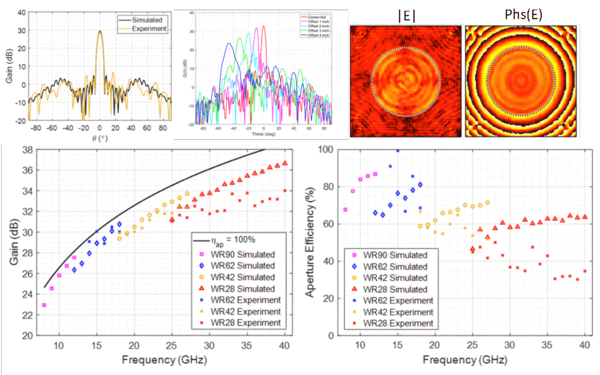GRIN Lenses for Millimeter-wave Communications and Sensing
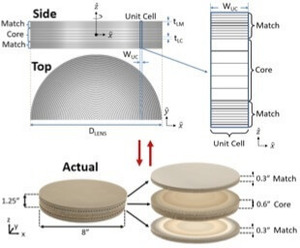
Beam-scanning MMW antennas have become the backbone of next-generation wireless communications systems, are necessary for satellite-tracking base-stations, satellite-communications (Satcom) on the move, are heavily used in radio astronomy and earth/planetary science missions, and even now in 5G millimeter-wave base-stations. We have developed a number of key technologies to enable high aperture efficiency, ultra-wideband, and wide-angle beam-scanning gradient-index (GRIN) lens antennas which provide a low-power and low-cost alternative to the conventional phased array. Our lenses are intrinsically matched over extremely wide bandwidths, covering from 8-80 GHz with aperture efficiency above 30% but typically from 50-80%.
Our work includes:
- High-contrast GRIN media: DRIE-based silicon perforated dielectrics [P1,2017B] (up to 500 GHz); low-loss drilled substrates (up to 100 GHz); 3D-printed lenses; low-cost metallo-dielectric GRIN [2019A] and low-dispersion metallo-dielectrics [2022D] for wideband low-cost applications.
- Lens Architectures: Switch-fed single-lens aperture antennas[2020A]; fan-beam lens antennas for low-profile applications[2022B]; lens arrays for shallow-depth applications; compound lens systems for high-performance wide-angle beam-scanning[2022A,2022B].
- Design methods: Transformation optics; intrinsically matched library design for rapid and automatic design of ultra-wideband, efficient antennas at broadside[2020A]; closed-loop optimization with in-house FDTD [2021A] codes to realize designs with arbitrary figure-of-merit and many degrees of freedom (including GRIN profile, lens shape, focal surface, and more); curved-ray geometrical optics with diffraction for rapid and accurate 3D GRIN lens optimization [2022C].
High-contrast GRIN media
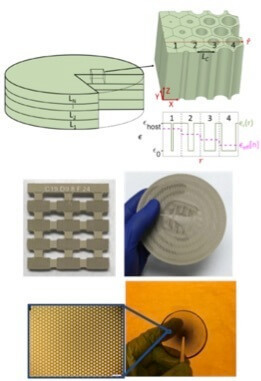
We have developed two approaches to high-contrast GRIN media. One uses industry-standard drilling of low-loss microwave substrates (e.g., Rogers AD-series) and is preferred for GRIN lens designs operating from 8 to 100 GHz [2020A]. The other uses an advanced deep-reactive ion etching [P1,2017B] process (Bosch) and our in-house annular masking method to achieve a wide range of effective permittivity by etching hexagonal voids on a hexagonal lattice in high-resistivity silicon wafers. This method targets lens designs from 100-500 GHz.
In contrast to traditional homogeneous lens antennas, GRIN lens antennas continuously manipulate the electromagnetic wave as it passes through the lens volume. These many degrees of freedom allow for high performance including efficiency with wide scan angle, thinner lenses, and aggressive F/D ratios [2019A]. A 3D GRIN profile can be achieved in a variety of ways including 3D printing, or stacked layers of perforated dielectrics (shown at right). Due to a variety of material and practical limitations, most artificial dielectrics used in GRIN lenses have a low maximum dielectric constant (around 6—8) and a high minimum dielectric constant (around 2—4) resulting in thick lenses which are poorly matched. Our GRIN media was developed from the beginning to provide high-contrast with low minimum permittivities [2017A]. The high maximum permittivity allows us to design thin lenses which can still produce a true time delay and thus wideband performance. The low minimum permittivity allows us to achieve unprecedented impedance matching performance over polarization and achieves record aperture efficiency over wide bandwidths.
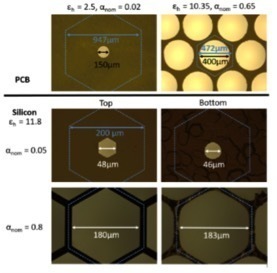
For lower frequencies and larger lenses (e.g., 4” to 18”) we use a drilled PCB process (upper images at left) wherein a standard drill set is used to produce circular voids in a low-loss microwave substrate[2020A]. Substrates are stacked to produce a 3D GRIN profile. Unit-cell sizes are limited by drill bit diameters and the minimum permittivity is limited by packing density limits (circles on hexagonal lattice). By using concentric rings of a range of substrates we can achieve an effective permittivity range from 1.57 to 9.20 (see colored traces in figure below).
For higher frequency applications where unit-cells must be an order of magnitude smaller, we have developed a custom deep-reactive ion etching (DRIE) process based on the well-known Bosch process to achieve hexagonal perforations on a hexagonal lattice. Since the voids are lattice-matched we can achieve a lower fill factor and thus the entire permittivity range can be realized in a single wafer of silicon. The effective dielectric constant of our silicon DRIE GRIN media is 1.25 to 9.8. In order to achieve this in-plane gradient we have developed an annular-ring masking process. The DRIE GRIN media was developed for millimeter-wave and submillimeter-wave lens antennas in the 100-500 GHz range and targeting applications in space and planetary science spectroscopy as well as ultra-high data rate point-to-point communication links.
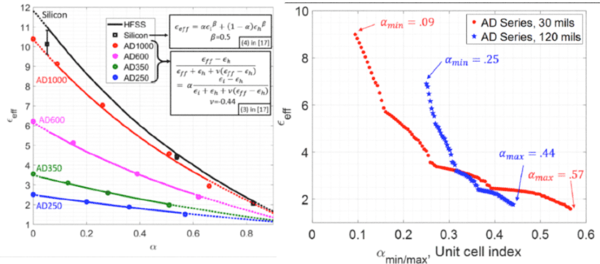
Lens Architectures
Using the GRIN media discussed above we have developed several lens design architectures that promote high aperture efficiency over wide bandwidths [2021A,2020A] and with high-performance beam scan [2022A,2022B]. Using intrinsically matched unit-cells we have demonstrated an 8” lens antenna with 30-80% aperture efficiency from 8-40 GHz with simulated operation up to 50 GHz [2020A]. With a switch-feed architecture, this lens can provide low-power, high-efficiency beam-scan for all current X-band, Ku- and Ka-band satcom systems as well as all proposed 5G millimeter-wave bands including 28 GHz, and 39 GHz. More recent work has focused on establishing unit-cell size limits for high-frequency GRIN lenses. Using this approach along with more advanced lens matching methods we have designed lenses with greater than 60% aperture efficiency from 8-80 GHz.
In addition to circular apertures with typical gain of 30dB we have designed a variety of high-performance fan-beam antennas that provide up to 80% aperture efficiency across similarly wide operating bandwidths. And, using compound lens systems we can achieve high-performance wide-angle beam-scanning with scan loss exponents close to the theoretical limit of 1.0 out to 45-degrees and broadside aperture efficiency of 60%. An example of a compound lens system is the aperture lens and feed-correction lenslet (FCL) concept shown below [2022A]. The FCL squints the feed pattern toward the center of the lens recovering almost all of the power lost to spillover at the edge of the lens (resulting in up to ~3dB increase in gain). In addition, the FCL shifts the phase center of the feed closer to the Petzval surface and results in more linear phase collimation, reducing coma lobe and improving aperture efficiency. This concept can be taken to the extreme in which a single monolithic GRIN feed lens is incorporated into the compound lens system [2022B]. The feed lens can be designed with a variety of objective functions to improve overall beamscan. For example, the one shown below is used to flatten the Petzval surface and reduce spillover loss as in the FCL concept but has the added benefit of being monolithic such that feeds can exist at any continuous offset. Full-wave simulations indicates a scan loss exponent of 1.1 and a measured scan loss exponent of 1.5, which is not ordinarily possible in lens antenna systems. This underscores the benefit of a compound lens system.
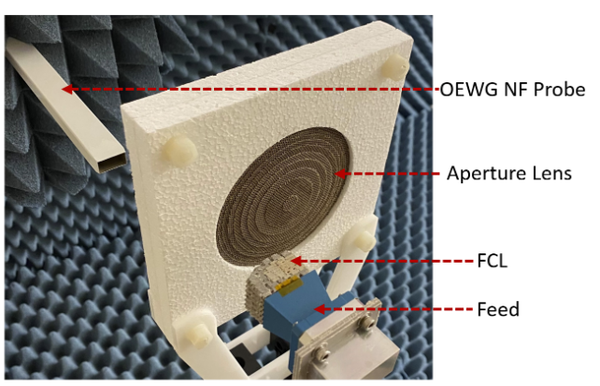
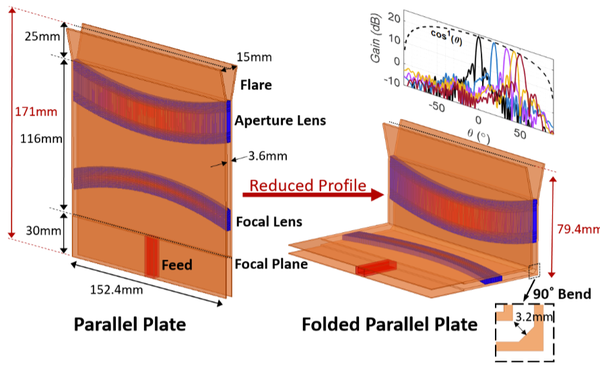
Design Methods
One of the key challenges in GRIN lens design is managing the complexity. A GRIN lens provides too-many degrees of freedom for traditional closed-form design methods (e.g., based on simple ray tracing) and simulation methods (e.g., full-wave EM with optimization). Therefore, we have explored a variety of design tools such as intrinsically matched unit-cells from which to apply ray tracing or optimization methods. Our current design tools allow us to create a candidate lens design, solve it with 2D FDTD full-wave EM solvers, and compute a wide variety of figures of merit and cost functions for e.g. scan loss optimization, bandwidth, and more in just a few minutes [2021A]. This allows us to perform lens design optimization with all of our lenses. We have two basic solvers: i) Geometrical Optics Ray Tracing with Field Amplitude Curvature, and ii) 2D FDTD. The ray tracing with field curvature is able to solve for the full vector EM field through an arbitrary GRIN profile with very high accuracy relative to rigorous full-wave analysis but in a small fraction of the time. Accuracy is dramatically improved, especially for scanned beams, by incorporating diffraction effects. We have incorporated diffraction through uniform asymptotic physical optics (UAPO) theory [2022C]. The 2D FDTD is a full-wave solver that takes advantage of rotational symmetry present in most GRIN lenses. It is not capable of solving the full vector field but can be used to optimize higher level system metrics such as impedance match, scan loss, etc. By combining the two codes we can arrive at highly optimized lens designs which take advantage of the righ parameter space available in a GRIN profile. This would not be possible if we relied solely on full-wave simulation or simplified ray trace anslysis.
Our codes also include rapid generation of 3D models for 3D EM simulation as well as Gerber files for fabrication. Using our wide array of design tools as leveraging our relationships with third party manufacturers we can go from lens specifications, through automated design and multi-objective optimization, to fabrication and first measurement in one to two months. This allows us to rapidly iterate on new concepts and push the limits of lens performance.
Geometrical Optic Ray Tracing with Field Amplitude
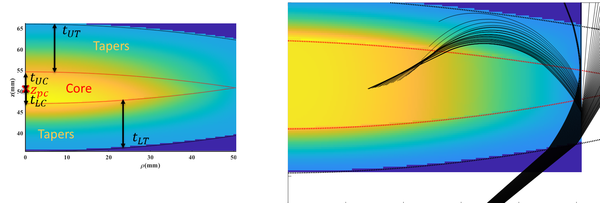
2D FDTD with Nonlinear Optimization
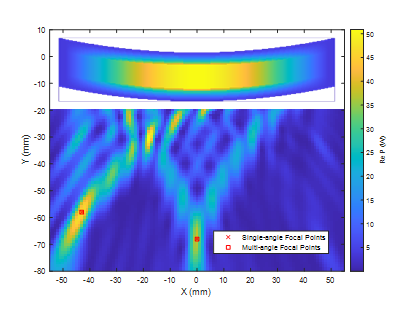
Measurement (Near-field & Far-field)
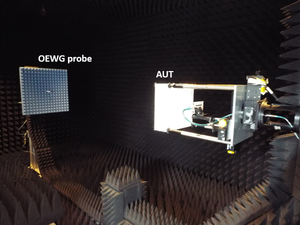
In order to characterize our GRIN lens antennas we conduct both far-field and near-field measurements. Our far-field range takes advantage of time-domain gated S-parameters in order to perform preliminary characterizations with line cuts. In order to produce a full characterization we perform near-field antenna measurements including our soon-to-be-completed in-house planar near-field antenna range as well as spherical near-field ranges with collaborators.
System Integration
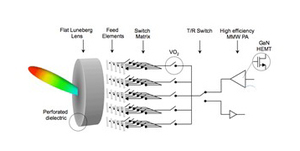
The lenses can be combined with a wide variety of electronics below the lens depending upon the application.
Another application of interest is in very low energy spectrum sensing and direction of arrival detection. Here we combine a GRIN lens with passive angular filtering with a compact filter bank (such as a cochlear filter) with a zero-bias diode energy detector. The result is a completely passive, zero-energy direction of arrival (DoA) spectrum sensor (except for the final readout which is effectively DC). This configuration is useful to deployment of SWaP constrained platforms such as micro-UAVs.
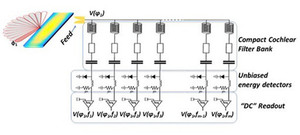
Relevant Publications:
[PhD Thesis] N. Garcia, "High-efficiency, Wideband Beam-scanning GRIN Lenses For Millimeter Wave Communications," March 2022, https://curate.nd.edu/show/wm117m0509s (Current POC: nico@cheshirgrin.com)
[2022A] N. Garcia, W. Wang, and J. Chisum, "Feed corrective lenslets for enhanced beamscan in flat lens antenna systems," Opt. Express 30, 13047-13058 (2022), https://opg.optica.org/oe/fulltext.cfm?uri=oe-30-8-13047&id=471156
[2022B] N. C. Garcia and J. D. Chisum, "Compound GRIN Fanbeam Lens Antenna With Wideband Wide-Angle Beam-Scanning," in IEEE Transactions on Antennas and Propagation, vol. 70, no. 9, pp. 7501-7512, Sept. 2022, doi: 10.1109/TAP.2022.3182420, https://ieeexplore.ieee.org/abstract/document/9799774
[2022C] W. Wang and J. Chisum, "Hybrid Geometrical Optics and Uniform Asymptotic Physical Optics for Rapid and Accurate Practical GRIN Lens Design," 2022 IEEE/MTT-S International Microwave Symposium - IMS 2022, 2022, pp. 20-23, doi: 10.1109/IMS37962.2022.9865499, https://ieeexplore.ieee.org/abstract/document/9865499
[2022D] J. Huang, C. Coverstone, and J. Chisum, "Low-dispersion Metasurfaces for Wideband Gradient-index (GRIN) Media up to Ka-band," 2022 IEEE International Symposium on Antennas and Propagation and USNC-URSI Radio Science Meeting (AP-S/URSI), 2022, pp. 1-2, doi: 10.23919/USNC-URSI52669.2022.9887514, https://ieeexplore.ieee.org/abstract/document/9887514
[2022E] W. Wang, J. Huang, H. Ouassal and J. Chisum, "Inverse GRIN Lens Design Using Artificial Neural Network and Geometrical Optics," 2022 IEEE International Symposium on Antennas and Propagation and USNC-URSI Radio Science Meeting (AP-S/URSI), 2022, pp. 1-2, doi: 10.1109/AP-S/USNC-URSI47032.2022.9887332, https://ieeexplore.ieee.org/abstract/document/9887332
[2021A] N. Garcia and J. Chisum, "Reduced dimensionality optimizer for efficient design of wideband millimeter-wave 3D metamaterial GRIN lenses," Microwave and Optical Technology Letters, 2021, v.63, pp. 1372– 1376. https://onlinelibrary.wiley.com/doi/10.1002/mop.32755.
[2020A] N. Garcia and J. Chisum, “ High-efficiency, Wideband GRIN Lenses with Intrinsically Matched Unit-cells,” IEEE Trans. Antennas Propag., vol. 68, no. 8, pp. 5965 - 5977, Apr 30, 2020, https://ieeexplore.ieee.org/abstract/document/9082819
[2019A] A. Papathanasopoulos, Y. Rahmat-Samii, N. Garcia, and J. D. Chisum, “A Novel Collapsible Flat-Layered Metamaterial Gradient-Refractive-Index (GRIN) Lens Antenna,” IEEE Trans. Antennas Propag., vol. 68, no. 3, pp. 1312 - 1321, Oct 4, 2019, https://ieeexplore.ieee.org/abstract/document/8859611
[2017A] W. Bai and J. Chisum, “A Compact, Wide Field-of-View Gradient-index Lens Antenna for Millimeter-wave MIMO on Mobile Devices,” VTC2017-Fall, https://ieeexplore.ieee.org/abstract/document/8288369
[2017B] N. Garcia, W. Bai, T. Twahirwa, D. Connell, J. Chisum, “Silicon Micromachined High-contrast Artificial Dielectrics for Millimeter-wave Transformation Optics Antennas” APS/URSI 2017, https://ieeexplore.ieee.org/abstract/document/8073028
[P1] (Granted) “High Contrast Gradient Index Lens Antennas,” #US 20200018874A1, Granted: Nov 2021. https://patents.google.com/patent/US20200018874A1
[P2] (Provision patent) “Compound lenses for improving beam-scan performance of reflector and lens antennas,” File: Apr 16, 2020. Application # 63/011,197.
Funding: NSF BWAC I/UCRC award #CNS-1439682-011, Parry Labs (Satcom-on-the-move) award #PL2018-SB-001, ONR (high-power, wideband radar systems) award #N00014-20-C-1067.
